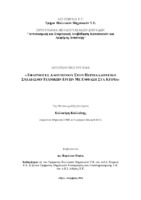| dc.contributor.advisor | Παραλίκα, Μαρία | |
| dc.contributor.author | Καλοκύρη, Καλλιόπη | |
| dc.date.accessioned | 2017-02-02T11:11:28Z | |
| dc.date.available | 2017-02-02T11:11:28Z | |
| dc.date.issued | 2016-12-15 | |
| dc.identifier.uri | http://okeanis.lib2.uniwa.gr/xmlui/handle/123456789/3214 | |
| dc.description.abstract | To αντικείμενο της παρούσας διπλωματικής εργασίας αποτελεί μία έρευνα στο σύγχρονο μέταλλο του αλουμινίου και των κραμάτων αυτού, τα οποία με διάφορες εφαρμογές χρησιμοποιούνται στο σχεδιασμό κτιριακών κελυφών, ικανοποιώντας τις απαιτήσεις της αειφόρου δόμησης. Το αλουμίνιο είναι το υλικό που αν και καθυστέρησε η απομόνωσή του διότι δεν υπάρχει στη φύση σε χημικές ενώσεις, παρά μόνο στα κοιτάσματα βωξίτη, παρήχθη ευρέως μετά την ανακάλυψη και χρήση του ηλεκτρισμού σε συνδυασμό με την έρευνα της επιστήμης της χημείας. Η λογική σχεδίασης του αλουμινίου και η εφαρμογή του έως το τέλος της ζωής ενός κτιρίου με ταυτόχρονα την ύπαρξη δυνατότητας επανάχρησής του με ανακύκλωση διαμορφώνουν τους στόχους λειτουργίας του κύκλου ζωής του κτιρίου με εξασφάλιση της πιο χαμηλής περιβαλλοντικής επιβάρυνσης. Κατοικίες, βιομηχανικοί χώροι, αποθήκες, εμπορικά κέντρα κ.λπ. σχεδιάζονται και αξιοποιούν τα δομικά τους στοιχεία από αλουμίνιο. Σήμερα η βιοκλιματική αρχιτεκτονική σχεδιάζει από δομικά κράματα αλουμινίου, τα σύγχρονα θερμοδιακοπτόμενα κουφώματα διπλών υαλοπινάκων, τις διπλοκέλυφες εξωτερικές επενδύσεις κτιρίων με φλοιούς αλουμινίου (αεριζόμενες όψεις), τα συστήματα σκίασης αλουμινίου και την κατασκευή «κρύων οροφών» λαμβάνοντας υπόψη την ενεργειακή απόδοση του κτηρίου στο χρόνο της ζωής του. Αυτά τα δομικά κράματα αλουμινίου δεν είναι τοξικά, δεν μαγνητίζονται, δεν καίγονται, είναι ελαφρά και στιβαρά, με μικρό κόστος συντήρησης και ποικιλία οικολογικών χρωμάτων. Τέλος επιπρόσθετα στην παρούσα διπλωματική εργασία παρουσιάζονται μέσω ερωτηματολογίου τα αποτελέσματα έρευνας, όπου με μια σειρά ερωτήσεων εκτιμούνται οι δυνατότητες αρχιτεκτονικού σχεδιασμού και η εκπόνηση υλοποιήσιμων καινοτόμων σχεδίων. Για την Ελλάδα έχει μεγάλη σημασία η προσπάθεια ενεργειακής εξυγίανσης των κτιρίων (εφαρμογή του Κανονισμού ΚΕΝΑΚ), ώστε η ενεργειακή απόδοση των κτιρίων να επιτρέπει την εξασφάλιση σε οφέλη, όπως ενεργειακά, περιβαλλοντικά και οικονομικά. | el |
| dc.format.extent | 212 | el |
| dc.language.iso | el | el |
| dc.publisher | Α.Ε.Ι. Πειραιά Τ.Τ. | el |
| dc.rights | Αναφορά Δημιουργού-Μη Εμπορική Χρήση-Όχι Παράγωγα Έργα 3.0 Ελλάδα | * |
| dc.rights.uri | http://creativecommons.org/licenses/by-nc-nd/3.0/gr/ | * |
| dc.subject | TPSH::Αρχιτεκτονική - Πολεοδομία | el |
| dc.subject | TPSH::Περιβάλλον | el |
| dc.subject | TPSH::Τεχνολογία::Τεχνολογία Υλικών | el |
| dc.title | Εφαρμογές αλουμινίου στον περιβαλλοντικό σχεδιασμό τεχνικών έργων με έμφαση στα κτίρια | el |
| dc.type | Μεταπτυχιακή εργασία | el |
| dc.contributor.committee | Δημάκος, Κωνσταντίνος | |
| dc.contributor.master | Αντισεισμική και Ενεργειακή Αναβάθμιση Κατασκευών και Αειφόρος Ανάπτυξη | el |
| dc.subject.keyword | Μέταλλα αλουμινίου | el |
| dc.subject.keyword | Κράματα αλουμινίου | el |
| dc.subject.keyword | Αρχιτεκτονικός σχεδιασμός | el |
| dc.subject.keyword | Αλουμίνιο | el |
| dc.description.abstracttranslated | The objective of the present work constitutes an investigation in the current Aluminum metal and its alloys, which are employed in several building applications, fulfilling thus the requirements of the sustainable building environment. Pure Aluminum production was delayed as it is not found in the nature as an “element “ of chemical compounds, but it is constituent of bauxite ores for which a commercial separation process was invented vey late. Aluminum is the material produced widely after the invention and exploitation of electricity in conjunction with the development of chemistry science with its industrial applications.The concept of designing Aluminum components in building applications, in order they last up to the end of the building life and simultaneously there is a possibility of reusing it by means of recycling, promotes the target of erecting buildings with smooth operation for their whole life cycle ensuring also the lowest environmental effect. Dwellings, industrial buildings, warehouses, and trading centers are designed and furnished employing to the maximum extent the metallic Aluminum and its alloys as construction element.Nowadays, the bioclimatic architecture adopts in the building design the structural Aluminum alloys for the modern thermal isolated doors and windows with double or triple glazing, the dual shell outer walls with Aluminum skins (ventilated facades), Aluminum shading systems, as well as the construction of “cold ceilings” taking into account the energy efficiency for its whole life cycle. These Aluminum structural alloys are not toxic, magnetized, and flammable. They are also light and stiff components with low maintenance cost, and they can be painted with a variety of ecological colors. Eventually, besides, the findings and results of a particular investigation through questionnaire are presented in the present work. By this questionnaire the feasibility of architectural design and the elaboration of developing innovative plans are properly assessed. For Greece it is quite important the energy retrofit of buildings by means of application of building energy efficiency regulation KENAK to be achieved, ensuring thus considerable benefits in energy consumption, protection of the environment, and national economy. | el |


